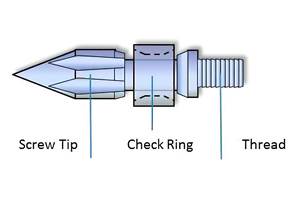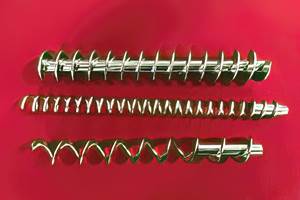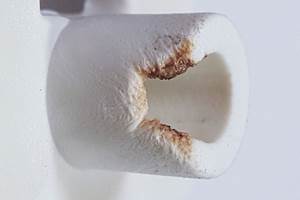Mobile-Drying Project Required ‘In-the-Box’ Thinking
Portable material drying by truck is the concept behind an initiative launched last month by Poly Clean USA LLC, Charleston, S.C., with Dri-Air Industries.
Portable material drying from a truck? That’s precisely the concept behind an initiative launched last month by Poly Clean USA LLC, Charleston, S.C. The novel venture is a spinoff of a somewhat related operation Poly Clean started in 1999: a five-truck “factory on wheels” fleet that brings various optical-sorting technologies right to processors, resin companies, recyclers, and compounders, allowing them to eliminate off-spec material without a single pound of resin ever leaving their plant.
The drying venture is aimed at processors and resin suppliers/compounders who are dealing with either seasonal or year-round problems with moisture, says Mark Richards, who co-owns . These clients may even have their own drying capacity—just not enough. “We go to plants where material is out of spec and help get it ready for processing,” says Richards.
Poly Clean worked with Dri-Air Industries, E. Windsor, Conn., to bring this project to fruition. “We needed someone who was willing to think ‘inside the box,’” says Richards, referring to the 8 ft wide x 9 ft tall x 28 ft long truck. Richards says Poly Clean has already signed up a client for the drying service—a 7 million lb/yr project—and has several others in the wings. He expects to expand the service beyond one truck as 911▒¼┴Ž═° dictates.
“The task we were given was to dry up to 1000 lb/hr of resin with a 6-hr residence time,” recalls Charles Sears, Dri-Air president. “Normally, this would be easy with a 1000-cfm dryer and 6000-lb capacity hopper on a stand outfitted with an appropriate hopper loader. But we somehow had to figure out how to mount all of the equipment in a truck that would not require a Class 2 license to drive,” says Sears. “So a trailer was out of the question. Obviously, standard equipment does not fit into a truck, as a 6000-lb capacity hopper is taller than a truck.”
Dri-Air’s design incorporated six modified 1000-lb capacity hoppers that each process 166 lb/hr. The six hoppers were divided into two banks of three hoppers, with a 500-cfm dryer for each hopper bank. As a safeguard in case the 6-hr residence time was insufficient, Dri-Air added its portable HPD-13 dryer, fed from the six drying hoppers, to act as a “finishing” hopper.
To fit within the truck’s height limits, the hopper cone was shortened and a take-off box with quick-clamp access was added. Low-profile, high-capacity receivers on top of each hopper left a 2-in. clearance to the top of the truck. Minor changes to the dryer allows access to all filters and servicing once in the truck.
Three loading systems were used. The first loads all six hoppers from material outside the truck. A 10-hp positive-displacement pump with a 2.5-in. common material line fills the six hoppers in rotation. The system is sized to load all six hoppers in less than an hour. After that, the dryers can be started as part of the 6-hr cycle.
Once dried, the material is closed-loop conveyed to the seventh hopper on the HPD-13 dryer. To meet the required throughput rate, two receivers are used on that hopper. While one receiver is loading, the other is dumping material into the hopper for a continuous loading cycle. After filling the seventh hopper, both conveying lines are purged of material to maintain dry material.
The dried material is then conveyed from the seventh hopper to a remote receiver using the 10-hp pump. The receiver can be mounted over the customer’s gaylord or similar container. Because the material in the hopper is fully dried, off-loading can be done either in batches or continuously.
Each hopper has its own heater for accurate temperature control. Temperatures are controlled by the master Unitronics PLC that also monitors and controls loading functions. For throughputs less than 1000 lb/hr, any number of hoppers can be used to maintain the proper residence time for that particular resin. Automatic air valves control the dry air flow to each hopper as they are turned on and off.
Related Content
Medical Tubing: Use Simulation to Troubleshoot, Optimize Processing & Dies
Extrusion simulations can be useful in anticipating issues and running “what-if” scenarios to size extruders and design dies for extrusion projects. It should be used at early stages of any project to avoid trial and error and remaking tooling.
Read MoreGot Streaks or Black Specs? Here’s How to Find and Fix Them
Determining the source of streaking or contamination in your molded parts is a critical step in perfecting your purging procedures ultimately saving you time and money.
Read MoreWhat to Know About Your Materials When Choosing a Feeder
Feeder performance is crucial to operating extrusion and compounding lines. And consistent, reliable feeding depends in large part on selecting a feeder compatible with the materials and additives you intend to process. Follow these tips to analyze your feeder requirements.
Read MoreBack to Basics on Mold Venting (Part 1)
Here’s what you need to know to improve the quality of your parts and to protect your molds.
Read MoreRead Next
For PLASTICS' CEO Seaholm, NPE to Shine Light on Sustainability Successes
With advocacy, communication and sustainability as three main pillars, Seaholm leads a trade association to NPE that ‘is more active today than we have ever been.’
Read MoreLead the Conversation, Change the Conversation
Coverage of single-use plastics can be both misleading and demoralizing. Here are 10 tips for changing the perception of the plastics industry at your company and in your community.
Read MorePeople 4.0 – How to Get Buy-In from Your Staff for Industry 4.0 Systems
Implementing a production monitoring system as the foundation of a ‘smart factory’ is about integrating people with new technology as much as it is about integrating machines and computers. Here are tips from a company that has gone through the process.
Read More












